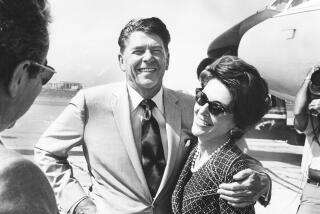Fuse It -- or Lose It
SACRAMENTO â Of necessity, Gov.-elect Arnold Schwarzenegger must run a fusion government. The presence on his transition team of such notable Democrats as Mayor James K. Hahn of Los Angeles, former Mayor Frank Jordan of San Francisco and former Mayor Tom McEnery of San Jose indicates that such a government is on Schwarzeneggerâs mind. The next governor is a Republican, but he cannot govern as one in terms of its current meaning in Sacramento -- ideological and fiercely partisan. Schwarzenegger, who will be sworn in Monday, must enlist the continuing support of at least 30% of Democratic legislators if he is to rescue and restore the state.
This will be an easier task if the new governor revives the bipartisan âParty of Californiaâ that animated four previous -- and great -- governors: Hiram Johnson, Earl Warren, Pat Brown and Ronald Reagan. The political practice and ultimate appeal of these leaders avoided the ideological trap that threatens to swallow California. Schwarzenegger would do well to hang framed portraits of these former governors in his office and to lace his remarks, as often as possible, with references to the Party of California. After all, it was in talking about what California meant to him as a young immigrant that Schwarzenegger gained his greatest rapport with the people during the recall campaign.
The core principle of the Party of California is that the state -- its history and heritage, its environment, its economy and, above all, the well-being of its people -- is worth imagining, worth struggling for; California represents a collective ideal connected to individual and social fulfillment. Everyone belongs to the Party of California. Everyone is welcome. When things get politically intractable, as they frequently do, everyone is entitled to appeal to the Party of California as the premise and matrix of political agreement.
Such an appeal was central to Johnsonâs fusion politics. Serving from 1911 to 1917, he is remembered today as the greatest governor in the history of the state. Why? He led the reform of California. Under his leadership, the Progressives, a Republican-dominated coalition with a strong Democratic wing, rescued and revitalized -- indeed, refounded -- California by redesigning its government. Conservative Republicans were always suspicious of Johnson, just as they are suspicious of Schwarzenegger. When Johnson went to the U.S. Senate, serving there from 1917 to 1945, he kept his Progressive designation on the ballot, along with his Republican one, just in case the GOP right wing turned against him.
Warren served from 1943 to 1953, when he was appointed chief justice of the U.S. Supreme Court. Some historians contend that he turned from conservative Republican to liberal Republican while on the court. Not so. Warren was a hard-nosed crime buster as attorney general, but as governor he was a fusion politician. His inner circle included Democrat William Sweigert, an Irish-Catholic attorney from San Francisco. He successfully urged Warren to push for such liberal programs as workersâ compensation and equal opportunity in employment. The two formed a kind of Masonic-Catholic odd couple, with Sweigert as the articulator of the liberal side of Warrenâs political imagination. The Republican governor was equally friendly with Atty. Gen. Robert Kenny, a Daniel Patrick Moynihan-like liberal intellectual who was strongly influenced by the social teachings of papal encyclicals. Once again, as in the case of Johnson, the Republican establishment, sensing the liberal in Warren, who would flower when he became chief justice, frowned on his fusionist tendencies.
Brown, governor from 1959 to 1967, began his political career as a Republican. He didnât, however, entirely leave his Republican self behind when he became a Democrat, because the GOP of his day had a highly respected moderate-to-liberal wing. When attorney general, Brown was so close to Warren that he should be considered a member of the governorâs inner circle. The two frequently drove to Sacramento from the Bay Area together. As governor, Brown enlisted key Republicans to support such programs as the water plan, the master plan for higher education, development of state beaches and parks, welfare expansion and fair-employment practices.
Republican Reagan, governor from 1967 to 1975, never forgot that he owed his political success in part to Democrats. As president, Reaganâs friendship with House Speaker Thomas P. âTipâ OâNeill, a quintessential Irish-Catholic Democrat from Massachusetts, had its prototypes in Reaganâs good-humored relations with key Democrats throughout his two terms as Californiaâs chief executive. Elected on an anti-tax platform, Reagan listened to Democrats once in office and, early in his first term, gave Californians the biggest tax hike in their history -- and got away with it.
Each of these four governors wrapped himself in the fusionist flag of the Party of California. Winning support from the opposition, they reformed California (Johnson), saw it through a postwar boom (Warren), refashioned its social programs and public works infrastructure (Brown) and made its programs and revenues sustainable (Reagan). Although anchored in their respective parties, each as governor became something more than mere partisan. They rewarded party loyalists -- and appointed outsiders to key posts. Effective speakers, they frequently invoked the ideal of a better California through corrective political action.
Governors since Reagan also practiced fusion politics. Jerry Brown continued his fatherâs habit of appointing qualified Republicans to the bench. George Deukmejian valued efficiency over ideology in deciding his appointments; and Republican Pete Wilson peppered his administration and judicial appointments with notable Democrats while maintaining good relations with the Democratic leadership in the Legislature.
Fierce partisanship has never been at home in California until recently. âBy their fruits you shall know them,â Scripture tells us. And by its fruits -- discord, legislative gridlock, mismanagement, hysterical and conflicting legislation, huge deficits, falling credit ratings -- we Californians know what fierce partisanship has wrought.
No governor in the history of this state comes to office with a more unusual profile than Schwarzenegger. Will his idiosyncrasy enable him to act according to a higher and more effective ideal? Will he bring back the Party of California?
More to Read
Get the L.A. Times Politics newsletter
Deeply reported insights into legislation, politics and policy from Sacramento, Washington and beyond. In your inbox three times per week.
You may occasionally receive promotional content from the Los Angeles Times.










